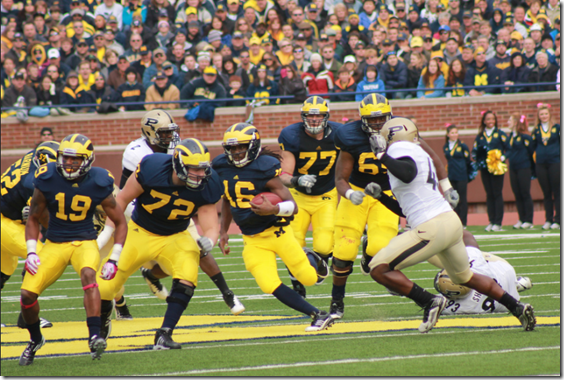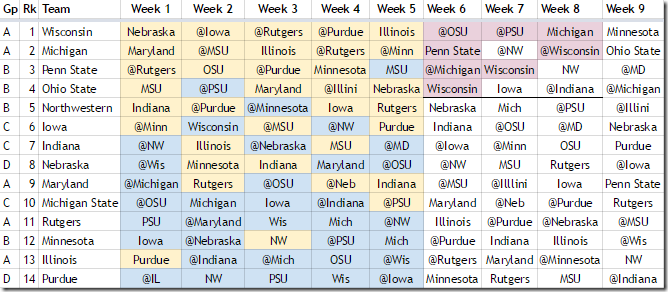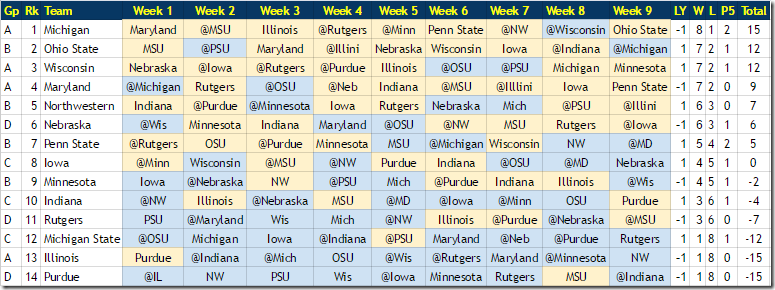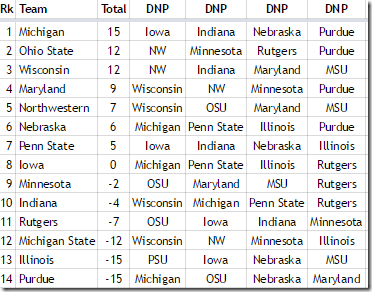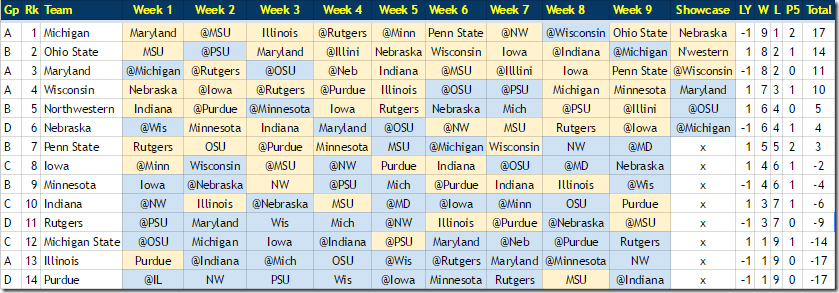Can you name all the Michigan players in this photo from the last Purdue-Michigan game in Ann Arbor? [photo: a much younger Eric Upchurch]
Since going to 14 teams the Big Ten schedule has been a mess. Some teams rarely face each other, other teams face each other twice a season. The divisions are historically and presently uneven. The last two years in a row this resulted in a Big Ten “champion” that had a demonstrably worse season than at least two other Big Ten teams. Congrats Penn State and Michigan State, but I think we can do better. In fact I have an idea how.
I’ll get into the details below but the idea isn’t for everyone to have to memorize the details. The simplest description is every year you play three locked-in rivalry games, three games of your choosing, and three games against schools near you in the standings. Your biggest rivalry is played at the end of the season, and its result (half) carries over to next season.
[UPDATE: On FiveThirtyEight’s Solution: Nate Silver’s proposal and mine share a few concepts: locked in rivalries early in the year, a mini-playoff at the end of the year, and eradicating divisions (which is essential to any good schedule reform). But it has two big flaws I tried to avoid:
1) It puts The Game in September, which: no, or in Week 7, which again: no, and then you’re seeding with less information.
2) Teams at the top will rarely face those at the bottom. I don’t like that because it cuts down on variety and could easily lead to things like long droughts between Michigan-Purdue tilts which are one of the things we’re trying to fix. Also it’s not good for the long term health of the conference since it would redistribute more losses from the bottom of the conference to the middle and middle-high. In effect it would result in fewer and lower ranked teams at the top, and fewer bowl-eligible teams from the conference. A few more competitive games is good, but 538’s proposal takes that to an extreme to the detriment of other important considerations.]
Goals:
- Maintain the annual rivalries and maximize their importance, keeping the big rival games at the end of the season.
- Play 9 conference games.
- Split up rivalry games so every team has a compelling schedule every year to sell to season ticket holders.
- Produce a fair and least disputable conference champion by playing all or most of the relevant games during the season.
- Play as many competitive games between similarly ranked teams as possible.
- No rematches!
- See a variety of opponents over a 10-year period.
- Encourage Power 5 opponents in non-conference scheduling.
- Be relatively simple.
The system I came up with hit all of these benchmarks to varying degrees (#9 being measured in Kelvin). #5 conflicts with #7 so I left it up to the schools themselves to prioritize between them. As for #9 it’s actually complicated, but can have the appearance of simplicity.
The schedule has four components:
- Three locked-in games versus your annual rivals.
- Three games where the top teams draft their opponents.
- Three games where you play like competition, and the top four teams all play each other.
- A “Big Ten Showcase” invitational during conf championship week to play the best three games that weren’t played.
DIVISIONS
This is the easy part. The teams are all separated into four pods of three or four with rivals they ought to be playing every year.
| Grp | Big Two, Little Bro | East Coast Cable Subscribers | Intercollegiate Conference of Maladroit Representatives | Corn Corn Corn Corn Cheese Corn Corn Corn |
|---|---|---|---|---|
| A | Michigan | Rutgers | Illinois | Wisconsin |
| B | Ohio State | Maryland | Northwestern | Minnesota |
| C | Michigan State | Penn State | Indiana | Iowa |
| D | x | x | Purdue | Nebraska |
The division names are not important but the order is—if you want a clue as to why, look at the A-B and C-D matchups. Teams in your pod are the two or three teams you play every year. There are two ways to handle the three-team pods and I haven’t decided which I like better—either works about the same:
- Option 1: Lock in rivals. Each team gets an annual rival from the opposite division, e.g. Michigan-Maryland is played the week of OSU-MSU, PSU-OSU always comes when Michigan plays State, and Rutgers-Michigan State is played annually on the last week of the season for bragging rights and the Situation Trophy.
- Option 2: Rotate every 2 years. So after two seasons of the above, Michigan plays Rutgers on week 1, Ohio State plays Maryland, and the Land Grant Trophy becomes the end-of-year rivalry for MSU. Then after two years it becomes M-PSU, OSU-Rutgers, MSU-Maryland.
I sorta prefer Option 1 but Option 2 seems more feasible.
[HIT THE JUMP to see how I worked it all out]
HOME & AWAY
This looks a little complicated but the gist of it is that every year your school’s season ticket package will include either two rivalry games at home, or one rival and five conference games.
| Week | Group A | Group B | Group C | Group D |
|---|---|---|---|---|
| 1 | Home vs C | Home vs D | Road vs A | Road vs B |
| 2 | Road vs C | Road vs D | Home vs A | Home vs B |
| 3-5 | 1/3 home | 2/3 home | 1/3 home | 2/3 home |
| 6-8 | 1/3 home | 2/3 home | 1/3 home | 2/3 home |
| 9 | Home vs B | Road vs A | Home vs D | Road vs C |
These flip every year. Fans will be able to buy season tickets knowing when and where the rivalry games will be played, and how many home games they’ll have in the meat of the schedule.
Ideally they’d know the dates of all of their home and road games beforehand, so a Michigan fan living in New York can plan a buddies weekend on, say, Week 6 knowing there will at least be a competitive game.
START THE CONFERENCE SEASON WITH 2 RIVALRY GAMES
These games are pre-scheduled and played every year on the opening two weekends for the conference. They never change, so you can always count on Michigan-Michigan State being at X venue on Y week. The first week Team A hosts Team D, and Team B hosts Team C. The two team A’s who don’t have a game play each other. The second week Team A plays at C and Team B plays at D. So here’s how that looks for our example 2017 season:
| Week 1 | Week 2 |
|---|---|
| Mich. St. @ Ohio St. | Michigan @ Mich St. |
| PSU @ Rutgers | Rutgers @ Maryland |
| Nebraska @ Wisconsin | Wisconsin @ Iowa |
| Iowa @ Minnesota | Minnesota @ Nebraska |
| Purdue @ Illinois | Illinois @ Indiana |
| Indiana @ Northwestern | Northwestern @ Purdue |
| Maryland @ Michigan | Ohio State @ Penn State |
So far simple enough. It’s still September and we’ve gotten some annual rivalries out of the way. We also have every team with 2 games played: a home and a road.
When to play this is up in the air. There’s an argument to make these games start in mid-to-late September so teams can get themselves geared up for conference season, as it’s always been. On the other hand since we’re determining the next part of the schedule later I think it’s best to play these games starting Week 2 of the regular season.
DRAFT OPPONENTS FOR WEEKS 3-5
If Michigan-Minnesota want more Jug dates they can prioritize that. [Patrick Barron]
To make the schedule for the next three weeks, we let the highest-ranked teams choose their own opponents. First we need to seed them, which I do thusly:
- +2 points for every conference win this year
- -2 points for every conference loss this year
- +1 point for winning last year’s big rivalry game.*
- +1 point per victory over power 5 team this year
- Tiebreakers: 1) head to head, 2) current AP rank 3) wins over P5 schools, 4) wins versus FBS, 5) points scored/points allowed vs FBS**
----------------------------------
* [Yes, the result of The Game last year counts for this year’s conference record. I’ll get into why I did this later on.]
** [Since we’re into unranked teams by this point running up the score is not so much a concern.]
----------------------------------
The first two teams pick their three opponents. The next two teams pick two opponents. Then 5 and 6 pick one opponent each, and the conference fills in the rest. When choosing opponents there are rules:
- No rematches. Can’t take a team they already played or a final week rival.
- Can’t choose a team ranked directly behind them (so the #1 team can’t take the #2 team at home and take away the #2 team’s right to choose their 3 opponents).
- Must respect Home/Away splits (so for example if a Group B team already has a road game scheduled you can’t schedule them for a road slot).
The opponent draft will be held, ideally, on Sunday or Monday of the week prior to the week the next round of games will be played, so fans will have most of two weeks to make their travel plans.
Why an opponent draft? Mostly because this way there’s some flexibility. Rather than leaving it up to the conference to juggle everyone’s needs (rivalries, homecoming, distance, draw, time since we last played, better opponents, easier ones, etc.) the schools themselves get some measure of control over their conference scheduling.
Giving the leading schools their pick of opponents gives more flexibility and lets fans have some input on who they play, for example Ohio State fans could push their athletic department to schedule Illinois if they haven’t played them very often in order to get the Illibuck Trophy back. Michigan might choose to schedule a game at Northwestern or Rutgers because they can knock out a road game and count on their fans to create a home atmosphere at those venues.
Let’s go back to our pretend 2017. Yellow means a team won their Week 1 or 2 game with said opponent, blue means they lost. Purple are the drafted matchups.
Undefeated Penn State was ranked higher than Wisconsin, and chose the easiest route with their two home games and one road, visiting Purdue and hosting Minnesota and Michigan State (they couldn’t take Rutgers since they already played). Wisconsin did the same, going to Purdue and Rutgers and hosting Illinois.
Michigan, held back by last year’s loss in The Game, is seeded 3rd, so we got two spots to fill, choosing to face arch-rival Illinois at home and, under immense pressure from Greg Dooley, taking Minnesota for their other road game. We wanted Northwestern but couldn’t choose them because they’re ranked directly below—Northwestern wanted no part of us, riding their easy early season schedule to an easier middle of the schedule with tilts at Minnesota and a visit from Rutgers. Ohio State opted for the Illibuck game in Week 4. Iowa chose Purdue. The conference filled in the rest.
Those games are announced, and then played, and everyone is re-seeded.
At this point we have a general idea of who’s in contention for the Big Ten crown and who isn’t. It’s time to punch your weight.
Note: I think this idea is cool and adds to the interest of a season, but it also can be done away with and replaced with pre-scheduled rotating games against the 10 teams you’re not locked into playing every year.
SEED OPPONENTS FOR WEEKS 6-8
This time there’s no draft—it’s seeded by the conference with the best teams playing each other and then working on down. First, any games between the top four league leaders that haven’t been played (or won’t be later) are locked in like so: Week 6 is 1v4 and 2v3, Week 7 it’s 1v3 and 2v4, and in Week 8 it’s 1v2 and 3v4.
The remaining empty spots are each filled, top-down, with the hardest opponent still available, with the higher ranked team getting the home game if they have one available.
For our example, I showed these mini-playoff games in salmon:
We now have a complete Big Ten schedule.
END THE SEASON VERSUS YOUR BIG RIVAL
The Game. Paul Bunyan’s Axe. The Oaken Bucket. The Situation Trophy. Whatever Illinois and Northwestern play for now. Something they came up with for Iowa-Nebraska. Penn State versus how stupid “Unrivaled” sounds. The BIG games! They’re all held the weekend before Thanksgiving.
You know, when the students are still in town, assholes.
And they are big, not just because they’ll determine your final seeding this year, but because you’re going to have to live with the result all next year as a +1 or –1 modifier on your conference record.
Let’s sim this out now and see where we stand. Remember scoring is +/- for last year’s rivalry game, +2 per win, –2 per loss, and +1 per non-conference Power 5 win.
So the winner of the Game takes the top spot in the conference. No need for conference championship games.
NO WE NEED MORE MONEY PLAY A CHAMPIONSHIP GAME
Interdivisional championship games are dumb. What the end of the season should be used for is to play the best games that weren’t played all year. If I had my druthers, I’d say get the Pac 12 to play the same kind of schedule then play our champions against each other in the Rose Bowl.
But for plausibility’s sake let’s say the Big Ten is going alone. I’d suggest then that we have a three-game showcase where we play the best three games of the year that weren’t played.
PREFERRED OPTION: Play in the higher seed’s home stadium.
REALISTIC OPTION: Rent out some NFL stadiums. If we’re going this route, let the top teams, in order, choose from the available venues, be they Ford Field, Indianapolis, Minnesota, Green Bay, whatever. Most plausible system would be to put two games in Indianapolis or Detroit, and one in the other, with the first two “hosts” having their pick.
Back to our simulated season to see who didn’t play whom:
The best team Michigan didn’t play is #6 Nebraska. Ohio State missed #5 Northwestern. Wisconsin skipped #4 Maryland. Let’s play those the week after Thanksgiving, again with 2 points going to victors and –2 to losers. Those left out also get –2 points. Trust me, it’s fair. You could also award 4 points to the victors and nothing to losers—it’s literally the same difference.
Huskers have to visit Ford Field, Ohio State makes Northwestern travel to Indianapolis, and Maryland upsets Wisconsin in Indy. End of Big Ten season.
HOW DID WE DO?
Let’s check in on the goals:
1. Maintain the annual rivalries and maximize their importance, keeping the big rival games at the end of the season.
✔ The rivalry games all get played in predictable weeks, with the biggest rivalries haunting you all next year as effectively half a game in the conference standings.
2. Play 9 conference games.
✔ Plus we snuck in a 10th for 6/14 teams.
3. Split up rivalry games so every team has a compelling schedule every year to sell to season ticket holders.
✔ The divisions were organized to put your biggest rival in Week 9, your next rival in Week 2, and that team you happen to share a region with in Week 1, so your top two rivals are never both home or away any given year.
4. Produce a fair and least disputable conference champion by playing all or most of the relevant games during the season, and play as many competitive games between similarly ranked teams as possible.
✔ The mix of the middling in Weeks 3-5 and the mini-playoff at the end made sure that the closer you got to the Big Ten crown, the harder your schedule was likely to get, producing a champion who’d already faced any other contender. Adding half-wins for last year’s rivalry game and power 5 opponents added information to produce far fewer ties. The best team that either Michigan or Ohio State didn’t play was #8 Iowa.
The winner of this was Northwestern, who got to skip Wisconsin and Maryland while playing two easy rivals to start the seeding, but that ultimately earned the Wildcats a visit from Michigan, and trips to Penn State and Ohio State.
5. No rematches!
✔ We made a rule.
6. See a variety of opponents over a 10-year period.
✔-minus. The pick-your-poison round provides an opportunity to schedule teams and head to venues that fans haven’t seen recently, if their schools so desire. Over time the top teams will miss the middle tier unless they choose to schedule them. That might be a good thing—is that 8th win for Iowa or 9th loss for Purdue more important to those respective teams?
7. Encourage Power 5 opponents in non-conference scheduling.
✔ Scheduling more P5 competition is incentivized by making those victories part of the conference formula. That doesn’t differentiate between Alabama or Vanderbilt but you don’t really want Big Ten teams playing Alabama outside of the playoff. There are no points to lose if you don’t win except in AP poll tiebreakers.
8. Be relatively simple.
Fail. This is a long article. But I think most people could behind “9 games: 3 vs rivals, 3 vs your choice, and 3 vs someone your own size, and your biggest rivalry counts for half a game next year.”
The draft portion should create a little bit more engagement. Also the teams are still going to be ordered by conference record—the difference between 8-2 and 7-3 is four points, so to make up that difference a team would need to have beaten its big rival last year and have three Power 5 wins in the non-conference portion AND have a head-to-head win or be ranked higher. At that point it makes sense.
OTHER PROBLEMS INHERENT IN THE SYSTEM HELP HELP MICHIGAN STATE IS BEING REPRESSED
I told you, we’re an anarcho-syndicalist commune.
There are some issues.
Michigan State has to start 0-2 every year. By locking in rivalries early in the year you’ll end up seeing a lot of the same teams drafting. If Northwestern beat Illinois the previous year and can get past Indiana and Purdue, they’ll usually be in a position to choose their opponents. By contrast Michigan State would have to defeat Ohio State and Michigan to ever pick whom they play. Hopefully it’s some consolation that a game with Rutgers is worth extra. Also catching their 5-star-recruitin’, high-turnover rivals earlier in the season should be an advantage a good MSU team would be in position to use. This isn’t a problem.
Fans don’t know who/when they’re playing. While the rivalry games are known far out in advance, imagine trying to plan a homecoming game in there. I tried having specific weeks be home/away ahead of time but it severely cuts down on the matchups you can offer/create in weeks 3-8. But we can have soft home dates (subject to change), where matchups get shuffled around after they’re made in order to fit each team’s home/road schedule.
Last year’s Game affecting this year? On one hand college football is about continuity and rivals, so making a rivalry game hang around your neck for another year is right in line with how things should be. But I get that wiping the slate clean every summer is part of the game. Ultimately this was the way to preserve the higher importance of end-of-the-year rivalries versus the rest of the schedule, but I acknowledge there’s something wrong with that.
Something else I didn’t think of? You tell me.
